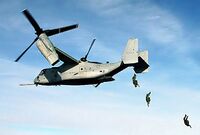V-22 Osprey
The V-22 Osprey, known alternately as the "Marine Corps Lawn Dart" as well as the "Pinto of the Skies," is the next-generation of faulty overpriced military hardware that is more of a threat to users than it is to any enemy. Envisioned as an aircraft possessing the strengths of both helicopters and fixed-wing planes while retaining none of the weaknesses, designers were unfortunately so burned out from sniffing Super Glue that they got the concept completely bass-ackwards. The result was the Osprey.
Among the most serious obstacles to the project was reconciling the fundamental differences between helicopters and fixed wing airplanes. The propulsion design of helicopters involves a single big fan on the roof, while airplanes use a number of little fans along the wings. Each design has its advantages: helicopters can crash in a straight vertical line, while airplanes can build up quite a lot of horizontal speed before plowing into the Alps. Ultimately, an aeronautical engineer looked at these advantages and, drawing upon considerable technical skills, decided to combine these features into one death-filled, high-flying hayride called the V-22 Osprey. (The proposed name, the V-22 OhJesusIdon'twanttodietellmywifeIloveher! didn't panel well.)
The Osprey's overall configuration is reminiscent of functional aircraft. A central fuselage is connected, via duct tape, chewing gum and bootlaces, to a pair of cardboard wings. At the end of these wings are the engine nacelles, randomly-detachable pods that house the engines and can swivel so that the propellers face forward or straight up. Original specifications also permitted them to swivel straight down to produce large-scale smoothies, but this feature was eliminated when Ron Popeil was fired from the project.
History[edit]
The modern V-22, like most military hardware, went through a series of revisions as it progressed from design to finished product. This is a natural procedure, since a fuck-up of this magnitude requires subtle addition of stupidity, applied over the course of years, to keep raking in defense contracting fees.
In 1986, Boeing aircraft, sick to the teeth of making reliable, safe, and comfortable vehicles, decided to turn its sights to new grounds. After partnering with Bell Helicopter, the two embarked upon a mystical voyage of engineering which, as evidenced by the result, was the victim of a great deal of technical skills.
As with any complicated deathtrap, there were numerous technical hurdles to overcome. First-round mock-ups failed to achieve flight at all, due to a communications failure between engineering and fabrication. The first prototype V-22, affectionately dubbed El Hindenburg, featured non-rotating propellers, but engine nacelles that spun at 2200 RPM. This error was later corrected. Boeing, sensing both an engineering blunder and a lawsuit magnet, vanished from the partnership, claiming something vague about having to return some videotapes.
Originally, the aircraft was designed to have a pressurized cabin. However, it was found that the cabin's seals were often breached when the wings were moved into storage position, or when the aircraft flipped upside down and slammed into North Carolina. Designers ultimately decided to scrap the cabin pressurization system when they ran out of technical skills. In its production design, the V-22 does not have a pressurized cabin, so at altitudes above 10,000 feet the crew must either wear oxygen masks or hold their breath. Oxygen is supplied by the On-Board Oxygen Generating System, guaranteeing a plentiful source of oxygen in the event of a fire. This generator is vital for crew safety above 10,000 feet, since lack of oxygen can lead to severe brain damage.
The Osprey's maiden flight was on March 19, 1989, during a solar eclipse, from a helipad built on a sacred Indian burial ground, by Captain Roger Curs of the legendary "Inverted Cross" experimental flight squadron. Captain Curs's first impression of the aircraft was of awe and wonder.
"Who the fuck built this thing?" he asked, "Cuisinart or Satan?"
The test flight was successful, as large parts of the aircraft became airborne following the double engine explosion at startup. A small piece of metal, believed to be Captain Curs' prosthetic left knee, glanced off the Mir space station later that day, giving the Osprey the distinction of being both the highest-flying aircraft in history, as well as mankind's first interplanetary vehicle.
Design[edit]
Numerous technical advances were made during the Osprey project. The Marine Corps decided to adopt the Navy tradition of going down with a stricken ship and fitted the Osprey with fly-by-wire systems. This guaranteed that, should the electronics or even the vanity mirror light fail during flight, everybody dies with the plane. The Osprey was originally planned to be a "glass cockpit" aircraft, where all the reliable gauges and indicator lights are removed in favor of scads of LCD monitors capable of simultaneously displaying the Blue Screen of Death. A V-22 variant, the MV-22B, built in partnership with Nintendo, retains the glass cockpit layout and adds three milnet-linked Nintendo Wii gaming consoles.
The avionics systems of the V-22 represent the cutting edge of technology, and were largely the responsibility of subcontractor Sega, a decision based on their proven aircraft engineering abilities, as shown by their success with After Burner II in 1987. The autopilot systems of the V-22 are so advanced that the aircraft can actually perform an automated landing without pilot intervention. The design specifications called for the autopilot to have the ability to go from forward flight to a 50' hovering posture, but landing is inevitably the result.
The computers of the V-22 are so advanced that they are able to take control of the aircraft during emergencies, such as when the wheels leave the ground. In one notable incident, the computer overrode the pilot of the aircraft eight times while he was trying to make emergency adjustments to a failing engine. This feature is continued on current models of the V-22. Instead of listening to the pilot's commands, the computer reassures the pilot, with a soothing voice, that everything is just fine, and that it's perfectly normal for fire to be shooting out of the engines. If the pilot continues his hysterics, the computer can bitch-slap him with the altimeter.
Curiously, the wings of the V-22 were deliberately designed to break off. This was done so that, in a crash, fuel from the wing tanks would be sprayed evenly across the fuselage, ensuring that no vital military supplies or personnel would survive to be captured and used by the enemy. This daring philosophy is likely to work as well in combat as it has during test flights in the enemy-filled reaches of Arizona.
Faults[edit]
Amazingly, for an aircraft of its complexity, 1.4% of its features are known to work correctly under all circumstances. The fact that the black box accounts for 1.4% of the aircraft's features is asserted by Bell Textron to be a mere coincidence. The other 98.6% of the plane works sporadically, infrequently, or never. The United States Marine Corps maintains an average Ready Basic Aircraft (RBA) percentage of 20% on this T/M/S (Type/Model/Series).
Worsening this track record is the plain fact that the layout of the craft was done by Shelly Armenwald, age 2, daughter of the senior designer of the project. Unlike modern combat transport helicopters, guns cannot be mounted in positions on the sides of the fuselage. The points in the fuselage normally occupied by defensive weapons are blocked by the engine nacelles and, although some argue that shooting the engines may improve the aircraft's performance, no accommodations for weapons in these positions have been made. The result is the conversion of a defense capable troop transport into a self-immolating Soldier Piñata for enemies on the ground to shoot at.
Weapons can only be mounted on the tail ramp, forcing the V-22 to back into a "hot" combat area. While this strategy is reasonably sound, most enemies are alerted by the V-22's backup warning beeper and tend to shoot at the noise. Plans are in progress to add a cannon in a chin turret mount and the addition will be made once Bell Textron engineers figure out how to steal one from the Pirates of the Caribbean ride in Disneyland.
Another minor issue with the aircraft is its reliability in desert environments. Tests have repeatedly show that when passing withing 200 nautical miles of a sand dune the V-22 nacelles are prone to bursting into flames, and falling off. Bell Boeing has pointed out this can be fixed by simply installing a maintainer into the nacelle to constantly clean it of the most minuscule particles of dirt, and dust.
Fast-roping is not an insertion option from the V-22. With the engine nacelles tilted to vertical for hovering, the downdraft from the propellers prevents soldiers from rappelling from the aircraft. This downdraft has been harnessed for good, however: in 1996, Cher bought a V-22 and had it installed in her home as a hair dryer, slashing her hair prep time to a mere 177 days.
Finally, and most glaringly, the V-22 is incapable of behaving like a normal plane. Since the propellers had to be enlarged to support a fixed-wing wannabe helicopter, the prop diameter is 38 feet. The V-22 stands 17 feet, 11 inches tall (18' 2" in heels). This means that if the engine nacelles are tilted level while the plane is on the ground, the V-22 Osprey Tilt-Wing Aircraft becomes the V-22 Osprey Giant Fucking Rototiller and explodes.
Reception[edit]
Many Marines have likened the V-22 to VA medical care—one can never be sure if the experience is survivable.
After the V-22 consistently failed performance and safety tests, a comprehensive program was launched to make the tests easier to pass. When the V-22 continued to fail, despite crib sheets and extensive steroid abuse, the program was shelved on December 12, 2000 at the cost of thirty billion dollars.
Five years later, the Department of Defense decided the V-22 had learned its lesson during its time-out and ordered the V-22 into full production. V-22 Ospreys were ordered for several branches of the military, all of which went on record as saying they'd rather take red Radio Flyer wagons to battle instead. The Pentagon told the various branches to sit down and be quiet, since they were getting the V-22 whether they wanted it or not.
"They're being extremely hypocritical," remarked senior Pentagon official Brigadier General Daniel W. Wasser, "The Marines have always said, 'It's not just a job, it's an adventure.' What better adventure is there than death?" Wasser was promoted shortly after his press release.
The US Army has wisely avoided so much as looking at the V-22, in fears that the friendless aircraft will follow them around all day boring them to death with mundane details of its life. The US Air Force has taken the different route of purchasing a small number of the aircraft as a hilariously expensive prank on it's tiny, and ill treated helicopter force. Currently, only the Marine Corps is seriously entertaining the idea of using the V-22, recognizing that, of the various services, Marines are unquestionably the most motivated and brain-damaged, often needing upwards of 30 minutes to determine they are, in fact, in a giant Kevorkian suicide machine. As a result, Marines are, much like Mr. T, routinely stunned prior to entering the aircraft, often not reviving until they are dropped into combat.
Specifications (V-22 Osprey)[edit]
- Crew: 2 pilots, 1 backseat-driving computer
- Capacity: 24 troops (36 if using disk compression)
- Length: 57 ft 4 in
- Wingspan: 46 ft
- Height:17 ft 11 in
- Rotor Diameter: 38 ft
- Fuckup Distance: 20 ft 1 in
- Empty weight: 33,140 lb
- Loaded weight: 47,500 lb
- Max takeoff weight: 0 lb
- Engine: Although classified, the evidence of multiple prop failures and subsequent deaths suggest that it might have one.
- Avionics Computer: Commodore 64 running Windows Vista, of course (with a Windows Millennium Edition option.)
- Airframe: Cheese.
- Cruise speed: 246 MPH
- Crash speed: Mach 37
- Combat radius: 46 ft
- Unit Cost: $More than a pickup. Rumoured to be more than two pickups.
- Development Cost: $700 squillion gazillion jillions. (Adjusted for inflation).
Just kidding—NASA's still calculating this one.
- The look on the face of a pilot just assigned to fly one: Imagine a particularly impressive heart attack.
| ||||||||||||||||||||||||||



